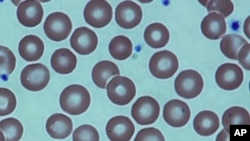Bone marrow transplants have become routine in the West for blood cancers, such as leukemia, and similar diseases. But experts say there’s no reason why the therapy should not be available in the developing world. There is need, but a shortage of resources, donors and expertise.
More than one million bone marrow transplants have been performed in 75 countries since the first one was performed in the U.S. 50 years ago.
That’s not very many for a treatment that can be lifesaving, according to Dietger Niederwieser, a professor of hematology and oncology at the University of Leipzig in Germany.
“We have situations where we have an identical [bone marrow] donor, and we have a disease which if treated early, the survival can go up to 90-95 percent even. So, it’s depending on the disease, it’s depending on the donor and it’s depending also on the age of the patients and so on," said Niederwieser.
Red blood cells, white blood cells and platelets are produced in the marrow, or spongy tissue inside bones, by stem or master cells.
Transplants — either from a closely-matched donor or using cleansed marrow from the patients themselves — are a way of replacing tissue that’s diseased by leukemia, a blood cancer, and lymphoma, a cancer of the lymphatic system.
For some patients, it is a last ditch effort at a cure.
Analyzing data collected by the Worldwide Network for Blood and Marrow Transplantation, Niederwieser and colleagues looked at the distribution of these transplants around the world.
Predictably, their study found that the bulk of the complex transplants have been performed in Europe, followed by the United States.
The remaining 15 percent or so have been carried out in South East Asia, the Mediterranean, Western Pacific and Africa.
Niederwieser says many developing countries have money to establish transplant programs, but they lack blood banks as well as the expertise to offer the complex treatments to sick patients.
“We want to help countries which have low transplant rate[s] to improve. So, it’s a success story," he said. "It’s an exponential growth of a treatment which is very complicated and which is now a routine treatment for many patients around the world."
The paper, published in the journal The Lancet Hematology, calls for collaboration between bone marrow transplant centers in the West and doctors in other countries who want to learn how to ramp up programs to perform the life-saving procedure.




